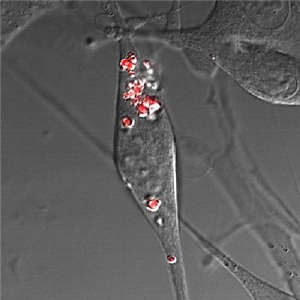Apr 6 2009
Researchers at the Universitat Jaume I (UJI) in Castellón have found porous polymeric materials that increase the efficiency of traditional photocatalysts in the treatment of cancer. Photodynamic therapy consists of introducing photocatalysts into tumour cells in such a way that when radiation (in the form of light) is applied, the photocatalysts destroy these cells as a result of the production of a reactive agent known as singlet oxygen. Santiago Luis and Francisco Galindo, lecturers in the Department of Organic and Inorganic Chemistry at the UJI, are directing the research, which is part of the thesis of Raquel Gavara. The research was selected to appear on the front cover of the January issue of Photochemical + Photobiological Sciences, a leading journal in the field of photochemistry.

“We have found porous polymeric materials and we have incorporated the photocatalyst into these materials and we have shown that they are more effective than the non-porous materials that have been employed up until now”, explains Luis. After studying the chemical reactions in the UJI laboratories, a second stage of research was performed in which these new photocatalysts were applied to cell cultures in the laboratories of the University of East Anglia, United Kingdom. There it was shown how, after melanoma cells are incubated with these materials, irradiation destroys the treated cells, whereas the cells not treated with these materials remain intact. “It is important to control the destruction of these cancerous cells by irradiation. When there is no light or when there is no photoactive polymer, they are not destroyed – both of these things are needed at the same time to destroy the cancerous cell”, emphasises Galindo.
Future stages will involve performing the tests in tissue, through collaboration with hospitals, with the ultimate aim of making an in-depth study of the advantages of the new photocatalysts in order to create more efficient and less aggressive therapies. The use of these new materials for photodynamic therapies would be especially suitable for treating skin cancers, which are easy to access with radiation in the form of light.
This research is the fruit of one of the lines of work of the group “Sustainable chemistry: supported reactants and catalysts. Supramolecular chemistry” of the UJI. Based on the concepts of supramolecular chemistry, this group aims to design sensors that serve to detect the presence of certain substances. Working with the technique of fluorescence, which makes it possible for a light signal to be seen as a consequence of the presence of something specific, they have arrived to this second area of work that enables the use of materials into which a substance can be introduced that will act as a photocatalyst. “A catalyst is a substance that facilitates a chemical reaction, making it faster and easier, but most importantly, a photocatalyst is a substance where this happens in the presence of light”, explains Luis.
Photocatalysts are of interest in different fields, with one of their first applications being in water treatment, since they make it possible for organic compounds or bacteria to be destroyed on exposure to sunlight or ultraviolet rays. Translated into the field of biomedicine, they are applied in phototherapy, enabling the destruction of malignant cells in a tumoural process. The discovery of materials that increase the efficiency of photocatalysts will enable more efficient therapies to be developed in the future.